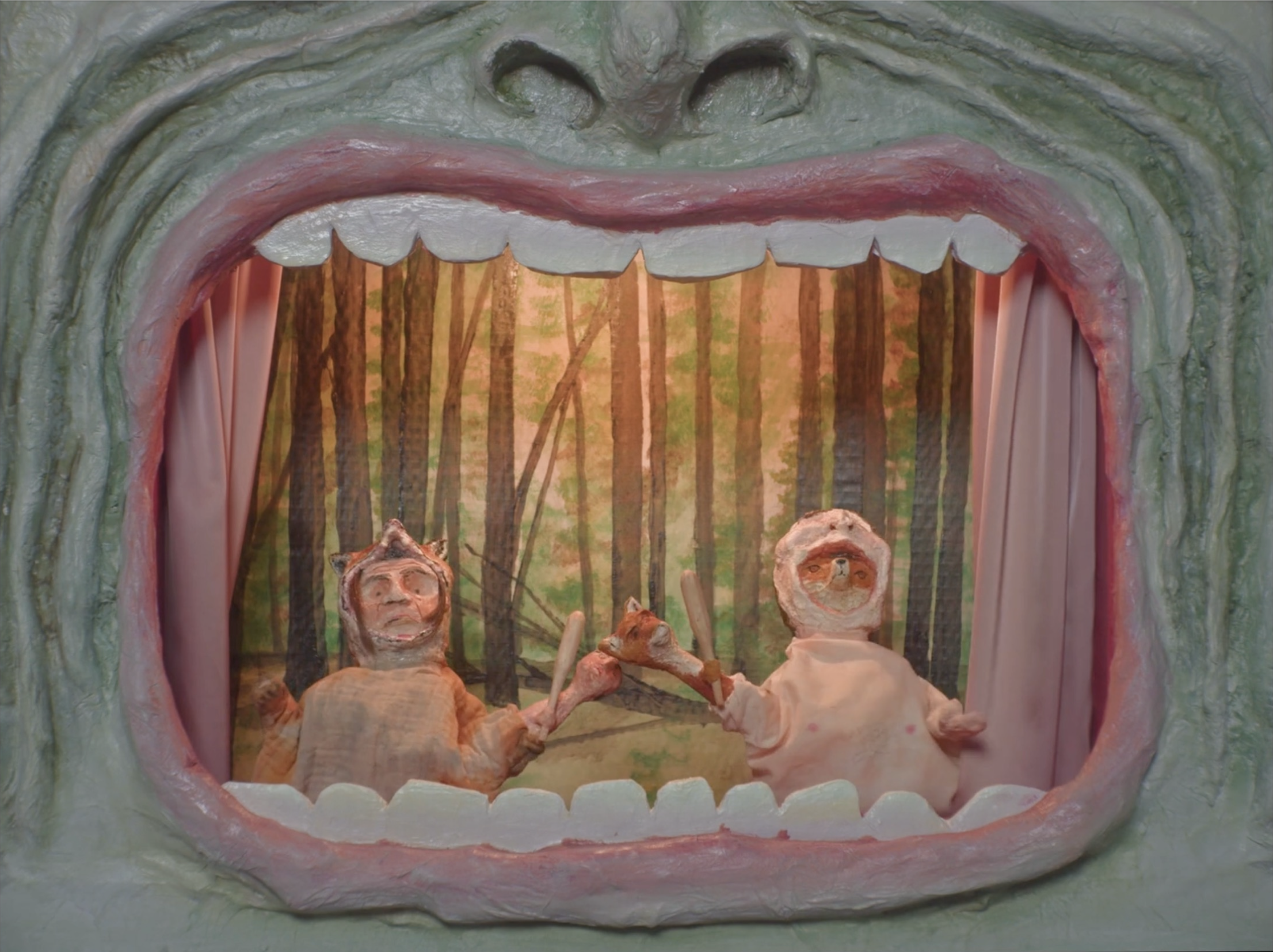—
JOY #4: Le Roman de Remort. Der Biss des Gewissens
JOY #4: Le Roman de Remort. Der Biss des Gewissens
Opening
December 4, 18.00 – 21.00
Screenings & Conversation between Marion Lessard and Adriana Disman
December 5
Screening Times: 16.00, 16.40, 19.00
Conversation: 17.30
For the fourth iteration of 17(joy), Jen Kratochvil has invited curator Ji-Yoon Han, who in turn has invited the collective Marion Lessard to take over the project space located at Schleifmühlgasse 17.
For the Viennese iteration of the video installation Le Roman de Remort(1), Marion Lessard transforms the gallery space into a lair visible from the street through a giant papier-mâché mouth. Through this in situ gaping hole, which fills and materializes the entire interstitial space of the window, passers-by are drawn to behold multiple reflections depending on the hour of the day or night: at times, they will catch sight of a film(2) that revisits, reenacts, and diverts the medieval animal fables of Le Roman de Renart [Reynard the Fox] into our era of the Ultimate Carnival; at other times, they will face the emptiness of a depopulated screening room, a cavity open to all forms of fantastical projection; or again, they may catch their own image, trapped on the hyaline surface encircled by Remort’s throat. The exhibition invites viewers to explore the vibrant energies of carnival, masks, and puppetry; to embrace the dizzying mise-en-abyme of the Verb, so specific to human existence; and to make space for the “bite of conscience” which, today, seems to clamp every joy within its parenthetical brackets.
To extend this play of nested frames, Marion Lessard in turn invites artist Adriana Disman to join her on Friday, 5 December 2025, for a screening followed by a discussion.
The artist book Remort & Mort-Due (in English and French) is available for sale during the opening and artist talk at the special price of 20 euros (cash only). Regular price is 30 euros (including shipping).
The artist-s dedicate this exhibition to the memory of their friend Gilles Blanchette, with whom they discussed art, death and laughter.
(1) Le Roman de Remort, literally “The Novel of Remort,” is a wordplay based on the original title of the medieval masterpiece Le Roman de Renart [Reynard the Fox], transformed into Remort, literally meaning “death again,” a homophone with remords, “remorse.”
(2) The film Le Roman de Remort, ou les fabliaux inhumains et vilains de l’Ultime Carnaval (2023) is accessible online for the whole duration of the exhibition here.
ABOUT MARION LESSARD
Marion Lessard is a collective of five individuals embodied within the same corporeal entity. Composed of Claude Romain, Élisabeth M. Larouine, Jean-Nicolas Léonard, Alice Roussel and Marie Cherbat-Schiller (all distinct personalities but with an inevitable family resemblance), the collective examines and brings out the linguistic, sociopolitical, psychic and logical structures that govern Western societies. Their practice in video, drawing, literature, performance, and public communications moves through the principles of identity, originality, and individuality, delves into paradoxical and dizzying mises en abyme, and reflects the philosophical paradoxes of the One and the Multiple.
Some members studied philosophy at the Université de Montréal, while Marion Lessard as a whole holds a Master’s degree in Studio Arts from Concordia University, Montreal. The Collective has taken part in notable artistic events such as MOMENTA Biennale de l’image (2023), the OFFTA Festival of Live Arts (2021), and the Triennale Banlieue (2018), all in Greater Montreal. Since 2017, they have exhibited in various galleries and artist-run centres, including Fonderie Darling—where it held a long-term residency at the Ateliers Montréalais (2019–2023)—, Galerie B-312, Dazibao, Verticale, as well as the Leonard & Bina Ellen Art Gallery at Concordia University.
ABOUT JI-YOON HAN
An independent curator and researcher, Ji-Yoon Han lives and works in-between Tiohtià:ke / Mooniyang / Montreal, Paris, and Seoul. Embracing an interdisciplinary approach, her projects explore the guiding and driving forces of art and artists within shifting social, cultural, and psychic contexts. Most recently, she was the guest curator of the 18th edition of MOMENTA Biennale de l’image in 2023 and a research fellow at the Photography Department of the Centre Pompidou – Musée d’art moderne (2021-2025). While developing institutional collaborations, she strives to cultivate long-term conversations with the artists she accompanies across several continents. Her curatorial practice is supported by numerous grants, including from the arts councils in Montreal, Quebec, and Canada. She holds a master’s degree in creative writing and a PhD in art history from the Université de Montréal.
ABOUT ADRIANA DISMAN
Adriana Disman is a performance artist, writer, and scholar. Since 2010, their solo works have been presented internationally, exploring “minor modes of resistance” and refusals of dominant power. Disman co-edited 50 Key Performance Artists (forthcoming winter 2026, Routledge) and has curated and taught performance in Canada, the US, Europe, India, and beyond. In 2023, they completed their PhD at Queen Mary University of London on the pathologisation of self-wounding in performance art.
17(Joy) is supported by Lombardi—Kargl, Federal Ministry for Housing, Arts, Culture, Media and Sport (BMWKMS), ERSTE Stiftung. JOY#4 is supported by the Conseil des arts et des lettres du Québec and the Québec Government Office to Germany, Austria, and Switzerland.
Inquiry
Please leave your message below.
